- Paperback - Number of Pages: 231 pages
- Dimensions: 187.96 x 231.14 x 12.7mm - 430.91g
- Publication date: 12 May 2010
- Publisher: Elsevier Science Publishing Co Inc
- Imprint: Academic Press Inc
- Publication City/Country: San Diego, United States
Preface Chapter 1. Classifiers Based on Bayes Decision Theory 1.1 Introduction 1.2 Bayes Decision Theory 1.3 The Gaussian Probability Density Function 1.4 Minimum Distance Classifiers 1.4.1 The Euclidean Distance Classifier 1.4.2 The Mahalanobis Distance Classifier 1.4.3 Maximum Likelihood Parameter Estimation of Gaussian pdfs 1.5 Mixture Models 1.6 The Expectation-Maximization Algorithm 1.7 Parzen Windows 1.8 k-Nearest Neighbor Density Estimation 1.9 The Naive Bayes Classifier 1.10 The Nearest Neighbor Rule Chapter 2. Classifiers Based on Cost Function Optimization 2.1 Introduction 2.2 The Perceptron Algorithm 2.2.1 The Online Form of the Perceptron Algorithm 2.3 The Sum of Error Squares Classifier 2.3.1 The Multiclass LS Classifier 2.4 Support Vector Machines: The Linear Case 2.4.1 Multiclass Generalizations 2.5 SVM: The Nonlinear Case 2.6 The Kernel Perceptron Algorithm 2.7 The AdaBoost Algorithm 2.8 Multilayer Perceptrons Chapter 3. Data Transformation: Feature Generation and Dimensionality Reduction 3.1 Introduction 3.2 Principal Component Analysis 3.3 The Singular Value Decomposition Method 3.4 Fisher's Linear Discriminant Analysis 3.5 The Kernel PCA 3.6 Laplacian Eigenmap Chapter 4. Feature Selection 4.1 Introduction 4.2 Outlier Removal 4.3 Data Normalization 4.4 Hypothesis Testing: The t-Test 4.5 The Receiver Operating Characteristic Curve 4.6 Fisher's Discriminant Ratio 4.7 Class Separability Measures 4.7.1 Divergence 4.7.2 Bhattacharyya Distance and Chernoff Bound 4.7.3 Measures Based on Scatter Matrices 4.8 Feature Subset Selection 4.8.1 Scalar Feature Selection 4.8.2 Feature Vector Selection Chapter 5. Template Matching 5.1 Introduction 5.2 The Edit Distance 5.3 Matching Sequences of Real Numbers 5.4 Dynamic Time Warping in Speech Recognition Chapter 6. Hidden Markov Models 6.1 Introduction 6.2 Modeling 6.3 Recognition and Training Chapter 7. Clustering 7.1 Introduction 7.2 Basic Concepts and Definitions 7.3 Clustering Algorithms 7.4 Sequential Algorithms 7.4.1 BSAS Algorithm 7.4.2 Clustering Refinement 7.5 Cost Function Optimization Clustering Algorithms 7.5.1 Hard Clustering Algorithms 7.5.2 Nonhard Clustering Algorithms 7.6 Miscellaneous Clustering Algorithms 7.7 Hierarchical Clustering Algorithms 7.7.1 Generalized Agglomerative Scheme 7.7.2 Specific Agglomerative Clustering Algorithms 7.7.3 Choosing the Best Clustering Appendix References Index




/yaootaweb-production/media/crawledproductimages/cf07c26173cf69b4d72a43297b3db1a112d16796.jpg)